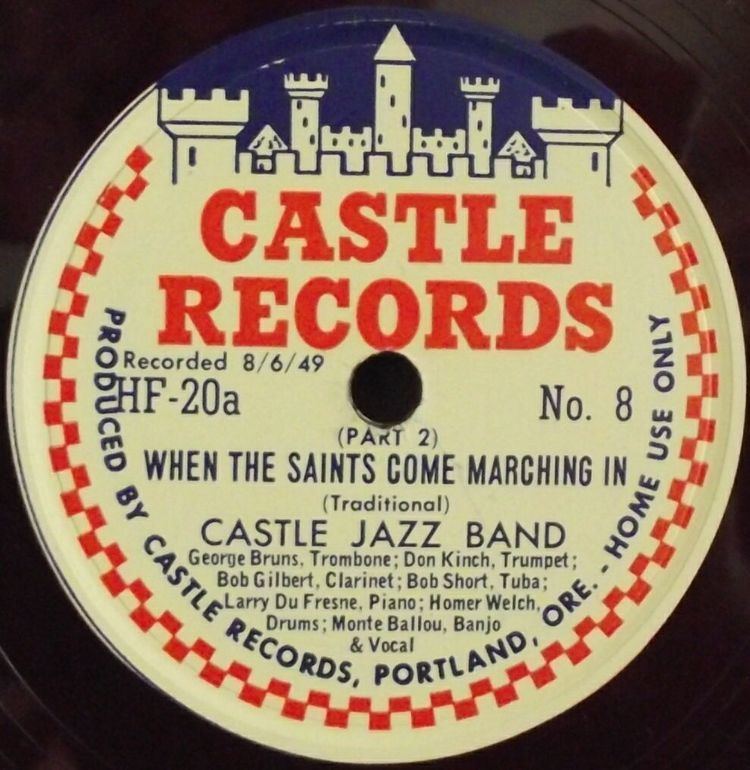 | ||
Similar | ||
Kansas city stomps by the castle jazz band 1949 wmv
The Castle Jazz Band was a Dixieland jazz band, part of the "West Coast revival" of traditional jazz music. Their recordings were popular worldwide for a time, although touring outside their Portland, Oregon base was limited.
Contents
- Kansas city stomps by the castle jazz band 1949 wmv
- Eccentric castle jazz band 1948
- History
- Style
- Impact
- Castle Records
- Personnel
- References
Eccentric castle jazz band 1948
History
The Castle Jazz Band started in 1944, part of a West-Coast revival of traditional jazz that un-apologetically rebelled against then-current developments in jazz. It was named after the Castle, an iconic roadhouse tavern located south of Portland (although at the time the group worked there they were simply called "Monte Ballou and his Orchestra.") The band, a cooperative venture that never paid its members, was led by banjoist Monte Ballou. The first recordings took place March 28 and April 16, 1944, and their first issue was limited to 200 copies. Wartime and employment difficulties ensured the band would not record again until 1947, but this recording was more widely distributed and garnered the nationwide attention of jazz fans and garnered critical acclaim. Ballou changed from guitar to banjo for the 1947 recording, and this, plus a change from string bass to tuba, had a significant effect on the band's sound. The most famous lineup was formed in 1948, and played music at the Jantzen Beach Amusement Park in Portland, dressed as various characters. They were regulars at the Rathskeller Cafe in 1948, and then moved to a more upscale location, the Sportsman Club, where they were a draw not only locally, but also from the traditional jazz fanbase in San Francisco. Their heyday was from 1949 to 1951. This time period included being a featured group at the 1949 Dixieland Jubilee concert, and a series of recordings on the Castle Records label that began in 1944. Trumpet player Don Kinch claimed one of these records, Floating Down the Old Green River sold more than a million copies. George Bruns left in 1950 to join the Turk Murphy band, and was replaced by initially by George Phillips (who had worked and recorded in the earlier edition of the band), and then by Rod Levitt. Levitt was considered too "modern" for the band and initially found it difficult to fit in. The cooperative band disbanded in 1951, and Ballou formed a new version of the band that performed in a club he bought called the Diamond Horseshoe, in good part due to the success of the Castle Records releases. Ballou sold the club in 1954, and disbanded Castle, in order to briefly join forces with Doc Evans.
After his time with Evans Ballou reformed the group and continued to work various venues in the Portland area in addition to private engagements. Members of the 1949-50 band were reassembled in the late 1950s to make two LPs for the Good Time Jazz record label. In the early 1960s Ballou led the band for a steady engagement in the Roaring 20s club in Harvey Dick's Hoyt Hotel, but when that ended in 1966 Ballou found it difficult to find another steady engagement for the group. However he continued to perform sporadically in the Portland area, often as a single act as he had done in his younger days. Periodically he would assemble a six or seven piece for concerts and recordings, including sessions in 1968 and 1972.
Style
The Castle Jazz Band was an all-white traditional jazz ensemble. It was composed of top-notch musicians who considered themselves neo-traditionalists; as such they rejected big band music as over-arranged and Bebop as the domain of "drug-addicted crackpots". Castle stuck to what they considered the roots of jazz, consisting of trumpet, clarinet, trombone, tuba, drums, banjo and piano. There were no saxophones or strings. They aimed to emulate the music of Jelly Roll Morton and King Oliver The band was reviewed as "rousing" and having the ability to impart "fire" to "cornier" numbers. Of importance to the band's success was the "rhythm and enthusiasm" of Ballou, and Kinch's trumpet which could evoke Bix Beiderbecke. Also important was the "hell of a good time" the band was able to communicate. Individual solos were limited in the Castle band, usually to just a bridge. They were considered to be an "superior, authentic, two-beat" band. The band was well-rehearsed, but did not come off as overly polished. Of greatest importance was blend of the ensemble work, or as Kinch put it, "It's your sound that matters."
Impact
The Castle Jazz Band was Portland's most popular jazz group, both locally and internationally. In the late 1940s, they were among four groups which were leading the traditional jazz movement on the West coast. George Avakian stated that the band made Oregon "a better place to live" and considered them the acme of semi-professional jazz groups at the time.
Castle Records
Castle Records was founded to release the band's records. The first recording, from 1944, was issued in a quantity limited to 200 copies, and a second release was even more limited at 50 copies. The label's first issues were primitive sounding, but as recording engineer Harry Fosbury continued, the sound quality improved. In addition to the Castle Jazz Band, Castle Records also released four piano solos by Lee Stafford. The recordings for the label took place between 1944 and 1950.
